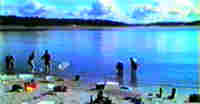|

They
are wonderful
|
|
Beaches that are composed of large sand
grains with a low organic content, are exposed to powerful wave action
and are well drained and oxygenated. Here, animals can live in the bottom
sediment. Beaches that are more protected from wave action, have finer
sand grains with more organic material, exhibit powerful chemical reactions
when the bottom sediment is disturbed. Most organisms that live here,
do so in the shallow, oxygenated layer near the bottom sediment. (More
about oxygen deficiency later)
Sediment particle size and form are of importance because
they affect the size of the space between the particles. These spaces
constitute the living-space for many microscopic organisms. Particle size
also affects the water content and flow through the sediment, aswell as
oxygenation. Water content is an important factor, as it affects how easily
organisms can dig down into the sediment, degree of oxygenation. and the
sediments ability to protect organisms from dessication and extreme temperatures.
Sand beaches are difficult to live on
There are many reasons why a sand beach
can be an arduous living environment. Fluctuations
in sea level cause intense variations in desication and temperature,
especially in the upper reaches. Other difficulties are variations in
saline content
as a result of rain, floods and drought, and the transplantation of the
whole living environment due to storms.
Variations on different levels without noticable boundaries
It is important to remember that all these
natural environmental factors are often very gradual and extend from different
natural extremities, and that transitions can take place over both short
and longer distances.
|

|
Page 5
of 15
|

|
|